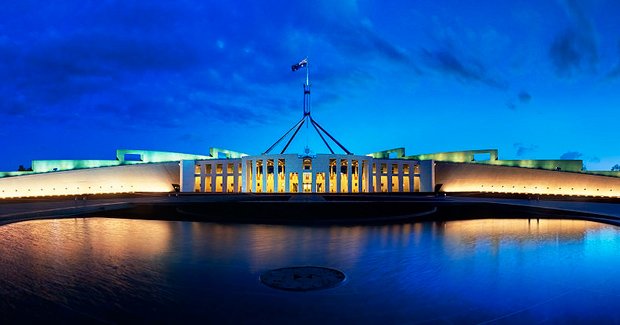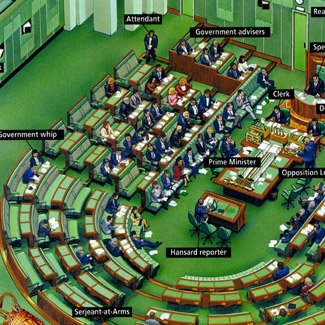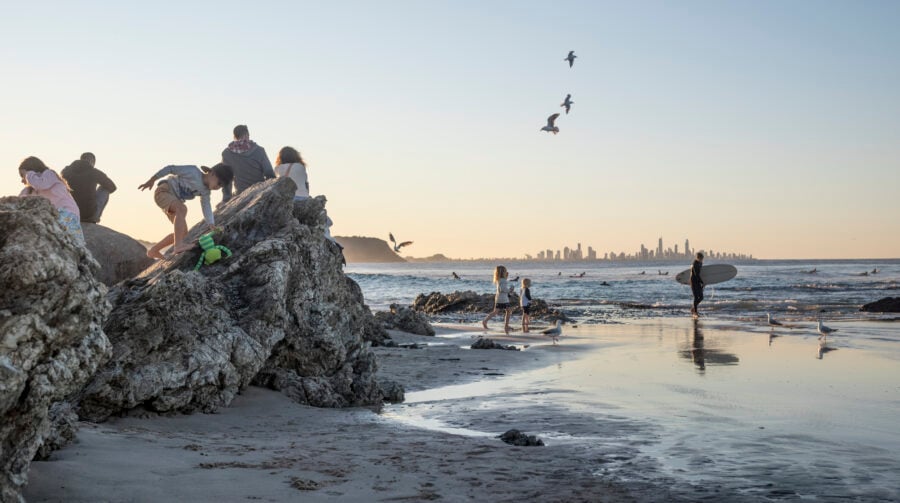How Australia’s parliament works

OUT NEAR WILUNA IN the centre of Western Australia, about as far in the country as you can get from Canberra’s political tentacles, the early-morning sun stretches the long frame of the Member for Kalgoorlie into an even longer shadow. He stands on rust-red sandy loam, head up near the top of trellises hung thickly with table-grape vines, and listens. He hears not just the words of the bloke in front of him, but the sentiment behind them the mood of the bush: his voters, his patch.
It’s only 5.30 a.m. and the MP Barry Haase and I have squeezed this tour of the Gunbarrel Vineyard into a whirlwind, three-day, 4100-kilometre trip around part of the 2.3-million-square-kilometre Kalgoorlie electorate. We dropped in on tiny Aboriginal communities such as Patjarr and Burringurrah, remote outstations, shire councils, schools and businesses, zipping between each in a little six -seater plane.
Wherever we went, someone would be in Barry’s ear: about high fuel prices, the state of rural roads, unemployment, telecommunications, the GST. “They don’t get to see too many politicians out here, so they like the opportunity to have their say,” Barry said. Everyone of the 148 Members of the House of Representatives has an area, called an electorate, that they represent.
Barry has by far the largest electorate in the country – all of WA bar the south-west corner. It’s more than 88,000 times the size of the smallest -Wentworth in eastern Sydney. “In the last 14-day period, I’ve travelled 35,000 km,” he told me. “So much of my time is taken up with getting to places.”
Each electorate has about 81,000 voters (or 120,000 people) who, regardless of their political persuasion, can approach their representative for help on any issue. Earlier on this trip we’d met Peter Buchanan at Carnegie station, 300 km east of Wiluna. He’d been bogged in a mire of bureaucracy while trying to obtain a service medal for his efforts in the Korean War so he could attend an official ceremony. Barry’s office staff took over, contacting the Minister for Defence, and a medal was granted.
Later, while we were visiting St Barbara’s goldmine near Meekatharra, Barry’s mobile phone rang because someone in his electorate had a problem with their residency status. Within minutes he’d made several calls to help sort it out. “Statistics show that over a three-year period you will have a direct impact on the lives of seven per cent of your electorate,” Barry told me.
A first-timer in Parliament, Barry is a backbencher. His primary tasks are serving his constituents and supporting his party – the Liberal Party. He’s also a member of six Government committees, dealing with issues ranging from native title to tourism resource development, and these take up about a third of his time in Canberra.
More than a third of Members are not backbenchers; they have higher-profile jobs that take precedence over their electoral concerns and committee work. For example, my local representative the Member for Bennelong is the Prime Minister.
Others are whips, shadow ministers or ministers, parliamentary secretaries (who help ministers) or the Speaker. All of them have electoral-office staff who look after the needs of their electorates.
Out at Wiluna, grape grower Simon Thomas wasn’t going to miss his opportunity to make a point to his representative. The Government had indicated it might relax quarantine regulations in order to promote trade with countries such as the USA and Simon was worried this would allow vine diseases such as Pierce’s disease, which has ruined crops in California, to enter Australia.
As a member of the Agriculture, Fisheries and Forestry Backbench Committee, Barry promised to bring the issue up with the chair of the committee. “I’ll contact other vine growers and have them send in an avalanche of material saying ‘We don’t want these pests in here’,” he said. He told Simon he’d also chat with members of the trade committee and try to convince them to keep the trade embargo on table grapes.
Later on, Barry told me he had a few other avenues available to make specific points. In Liberal Party-room meetings, held weekly during the 20 weeks a year that Parliament sits, all backbenchers are given three minutes to have a say. “It can get pretty fired up,” he said of the closed door meetings. “There’s real drama and pathos in the party room.” There are also opportunities to air issues in the House itself, such as the nightly adjournment debate, when five or six Members each give a five-minute speech on pet topics from Alzheimer’s disease to arson.
The most effective way for a Member to push a point though, is to talk directly to the minister in charge of the relevant portfolio. As a backbencher you spend a hell of a lot of time trying to get the ear of a minister,” Barry said. “Generally you get their staff.” In fact, the closest backbenchers may get to some ministers is when sitting in the House of Representatives itself.

House of Representatives
PARLIAMENT HOUSE in Canberra looks deceptively small. Sunk into Capital Hill’s grassy slopes, only the fringes of the $1.1 billion building’s 24 hectares of covered area can be seen. Inside, a small town of up to 3500 people scurries over colour-coded carpets and down jarrah corridors, bustling between offices, coffee shops and the building’s 4500 rooms. Only about 10 per cent of the building is accessible to the public, but during a visit to Canberra, I explored realms behind the guarded doors.
Parliament’s most public persona is question time, a fiery period of about an hour in the House of Representatives when questions are asked without notice, usually of Government ministers. It’s spectacular theatre, with plenty of heckling, interjections and shouting matches across the room. Like a referee, Speaker Neil Andrew aims to maintain fair play, on occasions “sin-binning” Members who don’t pipe down after three warnings. “People ask why this can’t be friendly like their school or Rotary group,” he told me in his spacious office, “but this is not school or Rotary – these are people with opposing views on serious issues. This is a football match, not a kindergarten.”
His two “linesmen” are the clerks who sit at the desk in front of him in the chamber. Some of the highest public servants in the land, they know the rules and conventions of Parliament better than anyone, and provide advice to any Member who needs it at any stage.
Like many of the people to whom I spoke, head clerk Ian Harris was keen to reassure me that cooperation, rather than the combat-like thrust and parry of question time, is the norm in Parliament. About 220 proposed laws, or Bills, are presented in most three-year government terms, and about 80 per cent of them are considered non-controversial – the major parties basically agree to their content and work together to get them passed.
In order to increase the amount of this uncontentious legislation that can be processed by Parliament, a small version of the House of Representatives, called the Main Committee, was established in 1994. With two or three Members always present, it quietly chugs along while the House of Representatives is in session. “It can do everything except initiate business and take the final decision on business, and it’s been such a tremendous success that the English Parliament has decided to give it a try,” Ian said.
It’s somewhat satisfying to be exporting political process to the UK, because the Australian system of government was modelled on their Westminster system. It requires two “houses” of parliament – in our case, the House of Representatives and the Senate. To become law, a Bill must receive a majority of votes in both houses.
STRIDING QUICKLY, like everyone in Parliament House, I made my way towards the Senate side of the building, past the exquisite 14-tonne black-granite square that marks the very centre of Parliament House. Water flows from a cut-out in the middle of the polished slab, symbolically stating that no one should be able to stand in the centre of Parliament to dominate the two houses, not without getting wet and looking ridiculous anyway.
Down every corridor and in every room, I was in sight of at least one of the building’s 2500 analog clocks. Each clock has a red light and a green light. Members and Senators are often in their offices, in committees or elsewhere in the building while Parliament is sitting, but whenever a crucial vote is about to be taken, bells ring and one of the lights on the clocks flashes. If it’s green, the Members have a maximum of four minutes to rush to the House before the doors are locked and the vote taken. If it’s red, it’s the Senators who dart along the corridors.
A bleary-eyed Harry Evans, the Clerk of the Senate, greeted me at his paperloaded desk. The Senate had sat until nearly 4 a.m. two days ago and, like the 76 Senators, he was feeling the effects. The Government usually doesn’t hold the majority that would enable it to shut down a Senate debate, and as more minority parties and independents are represented here than in the House, Senate debates often last a lot longer. Harry wasn’t whingeing though.
“lt’s healthy to have a situation like that in the Senate, where the government of the day can’t just pass its legislation like that,” he said. “lt’s got to have regard for the views of other people and make compromises with them in order to get its legislation through. “One of the chief tasks of Harry’s department is to prepare the reams of paperwork needed for the running of the Senate. For example, if a Bill is being introduced into the chamber, the Senators who have “speaking parts” will receive a copy of a “script”, called a dit, with their part outlined in red. It doesn’t include any political speeches or points, just the correct wording for the procedure. “Senators are heavily dependent on advice,” Harry said. “Some of them come to us and say, ‘Give me the magic words’.”
Harry, who became Senate clerk when Parliament moved up the hill to the new building in 1988, lamented the current lack of long-term, older politicians who have a thorough knowledge of the Senate’s rules and procedures. “The institution has changed a great deal … politicians don’t stay as long, they have more pressures on their time and they just don’t have time to build up the expertise that they used to have.”
ON A SWEATY Canberra morn, a 10-minute stroll down the flag pole lined Federation Mall took me to Old Parliament House, Parliament’s home for 61 years. I’d spent several days inside Capital Hill’s vast arena, so the old building seemed like a doll’s house in comparison, with everything in miniature. Originally designed to accommodate a mere 200 people, it had dark-timbered, formal chambers just over half the size of today’s House and Senate, and offices no bigger than cupboards.
Many people who worked in the old building pine for its close quarters, where everyone was close to the action, and politicians, journalists and the public couldn’t help but rub shoulders. But current president of the press gallery, Malcolm Farr, isn’t one of them. He’s delighted with the 3300 sq. m of floor space allocated to the media in the new Parliament House. “Not even in Westminster is there a substantial allocation for the press – same in Washington, same in most other parliaments of the world,” he said. “Our allocation is a prime indicator of the importance of political journalists in Australia.”
As we discussed the media’s substantial influence on Government, Malcolm told me that in more than 20 years in the press gallery he’d learnt there was no guaranteed way of getting a piece of legislation passed. “Parliament’s a very human organism,” he said. “You don’t just throw a switch and the process gets completed under its own steam. You can’t ignore personalities and individuals; they’re the ingredients that can make or break an idea or concept. There are too many variables their perceptions of ideology, religion and each other. The system has all the flaws of human beings and all the advantages of human beings, and in the end, more often than not, something credible and workable gets through.”
IT’S NOT OFTEN you get to stump a politician. Back in WA, bouncing around in the tiny plane, Barry and I had agreed our system of parliament could be best described as a series of sieves. Information pours in by the truckload to backbenchers and Senators. They strain out the best chunks and transport them to ministers, any way they can. The top ministers, receiving bucketloads from everyone, take the best gems to their peers in cabinet, and some of these, through the refining centres of the House of Representatives and the Senate, eventually become law. But when I asked Barry whether the system worked, he was stuck. “Does it work?” he asked himself slowly.
Blue eyes, the colour of faded jeans, gazed out the window at the red dirt and scrub rolling beneath us, and his lower jaw chomped on his thumb. Perhaps he was thinking of the 140 nights a year he spends out in his electorate listening to countless complaints. Perhaps he was thinking of the compromises that must be made to achieve a goal. Perhaps the spectre of the next election and the votes that have to be won loomed in his mind. The propellers pounded in my head as I waited for his answer. Finally he spoke. “It’s sure not a perfect system, but it’s probably the best. Parliamentary democracy is the best there is.”
Source: Australian Geographic Issue 63 (Jul-Sep 2001)




